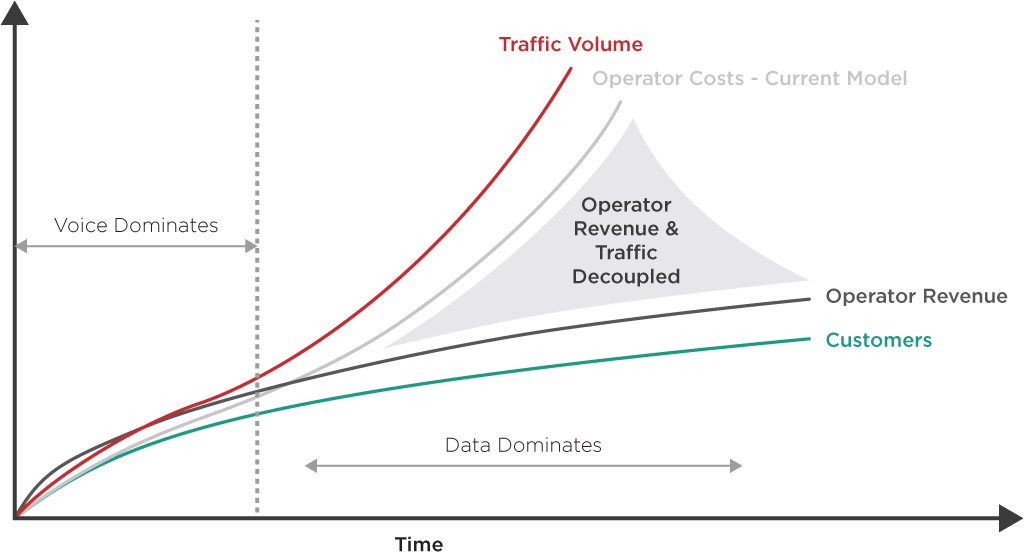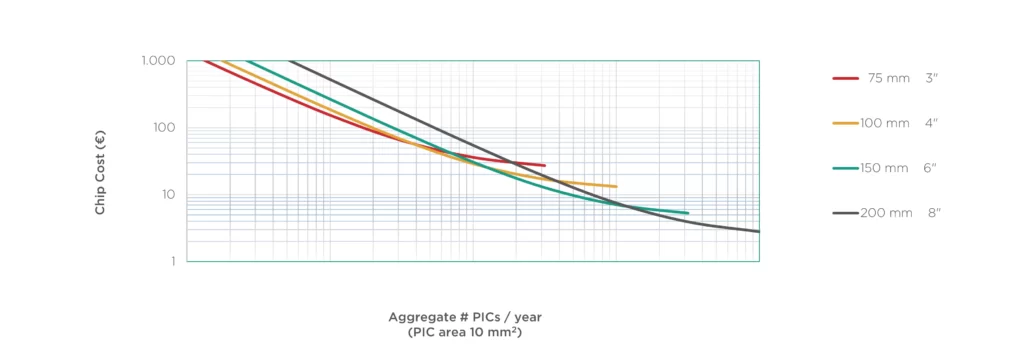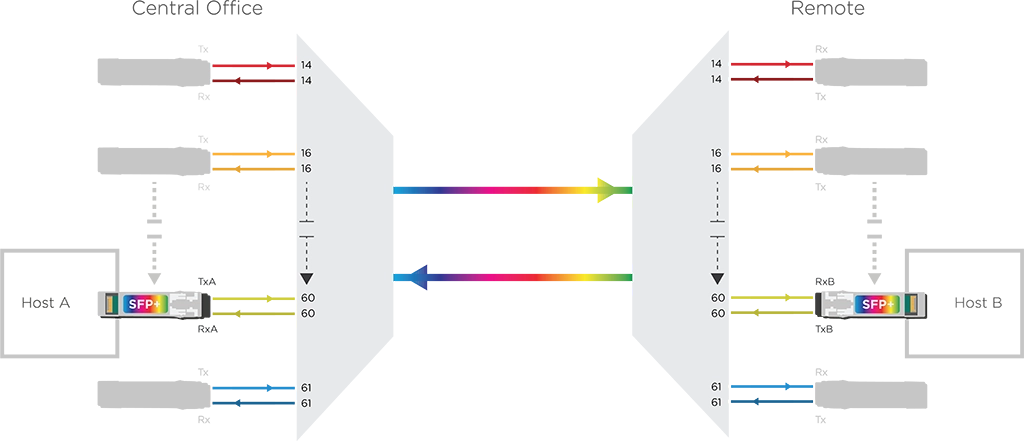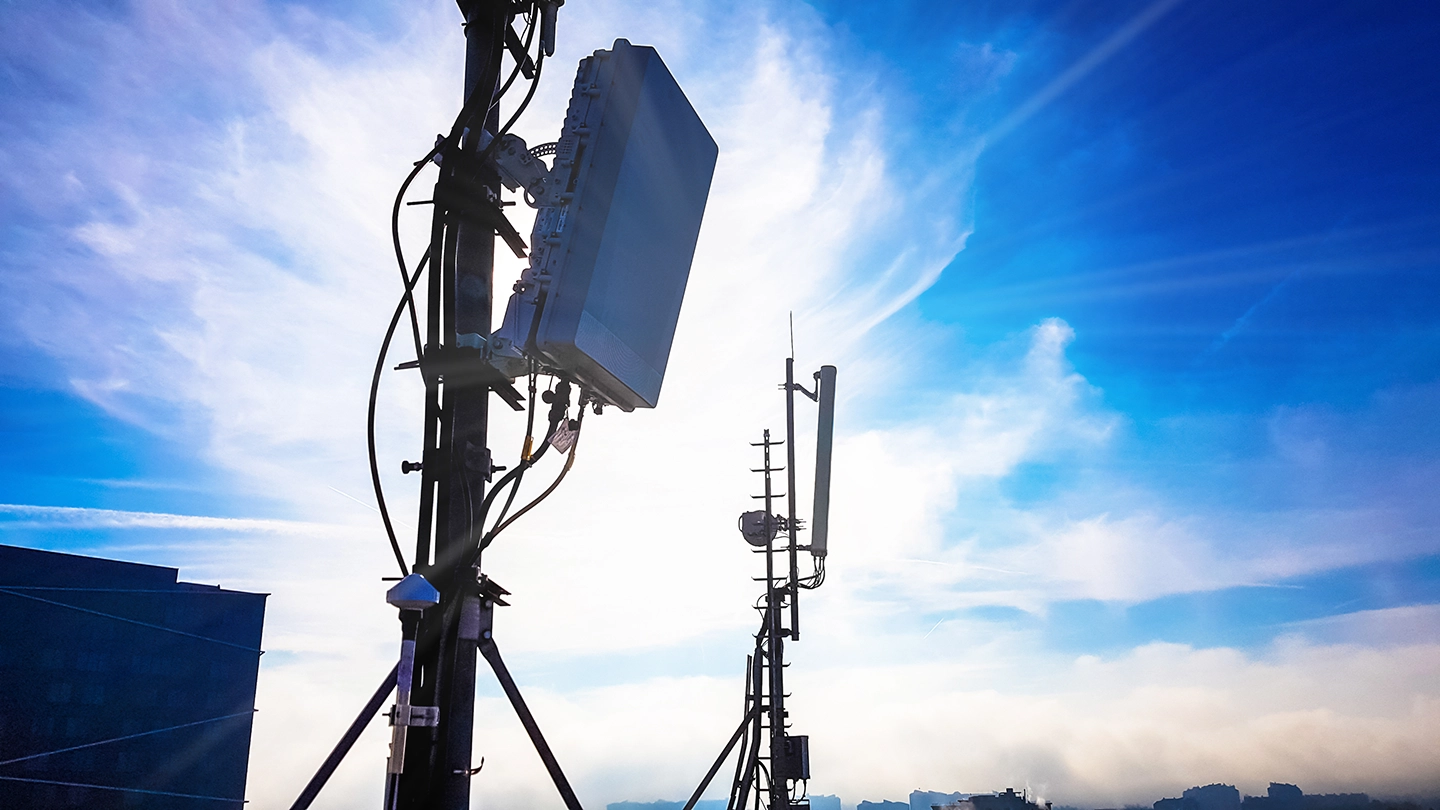Reducing the Cost per Bit in Access Networks
Every telecommunications provider has the same fundamental problem. Many decades ago, service providers addressed increased network demands by spending more money and buying more hardware. However, network operators cannot allow their infrastructure spending to increase exponentially with network traffic, because the number of customers and the prices they are willing to pay for mobile services will not increase so steeply. The chart below is one that everyone in the communications industry is familiar with one way or another.

Given this context, reducing the cost per bit transmitted in a network is one of the fundamental mandates of telecommunication providers. As the global appetite for data grows exponentially, fueled by streaming services, cloud computing, and an ever-increasing number of connected devices, the pressure mounts on these providers to manage and reduce this cost.
In access networks, where the end users connect to the main network, this concept takes on an added layer of importance. These networks are the final link in the data delivery chain and are expensive to upgrade and maintain due to the sheer volume of equipment and devices required to reach each end user.
This is why one of EFFECT Photonics’ main missions is to use our optical solutions to reduce the cost per bit in access networks. In this article, we will briefly explain three key pillars that will allow us to achieve this goal.
Manufacturing at Scale
Previously, deploying optical technology required investing in large and expensive transponder equipment on both sides of the optical link. The rise of integrated photonics has not only reduced the footprint and energy consumption of coherent transceivers but also their cost. The economics of scale principles that rule the semiconductor industry reduce the cost of optical chips and the transceivers that use them.
The more optical components we can integrate into a single chip, the more can the price of each component decrease. The more optical System-on-Chip (SoC) devices can go into a single wafer, the more can the price of each SoC decrease. Researchers at the Technical University of Eindhoven and the JePPIX consortium have done some modelling to show how this economy of scale principle would apply to photonics. If production volumes can increase from a few thousands of chips per year to a few millions, the price per optical chip can decrease from thousands of Euros to mere tens of Euros.

By integrating all optical components on a single chip, we also shift the complexity from the assembly process to the much more efficient and scalable semiconductor wafer process. Assembling and packaging a device by interconnecting multiple photonic chips increases assembly complexity and costs. On the other hand, combining and aligning optical components on a wafer at a high volume is much easier, which drives down the device’s cost.
Integration Saves Power (and Energy)
Data centers and 5G networks might be hot commodities, but the infrastructure that enables them runs even hotter. Electronic equipment generates plenty of heat, and the more heat energy an electronic device dissipates, the more money and energy must be spent to cool it down.
These issues do not just affect the environment but also the bottom lines of communications companies. Cooling costs will increase even further with the exponential growth of traffic and the deployment of 5G networks. Integration is vital to reduce this heat dissipation and costs.
Photonics and optics are trying to follow a similar blueprint to the electronics industry and improve their integration to reduce power consumption and its associated costs. For example, over the last decade, coherent optical systems have been miniaturized from big, expensive line cards to small pluggables the size of a large USB stick. These compact transceivers with highly integrated optics and electronics have shorter interconnections, fewer losses, and more elements per chip area. These features all lead to a reduced power consumption over the last decade, as shown in the figure below.

DWDM Gives More Lanes to the Fiber Highway
Dense Wavelength Division Multiplexing (DWDM) is an optical technology that dramatically increases the amount of data transmitted over existing fiber networks. Data from various signals are separated, encoded on different wavelengths, and put together (multiplexed) in a single optical fiber.
The wavelengths are separated again and reconverted into the original digital signals at the receiving end. In other words, DWDM allows different data streams to be sent simultaneously over a single optical fiber without requiring the expensive installation of new fiber cables. In a way, it’s like adding more lanes to the information highway without building new roads!

The tremendous expansion in data volume afforded with DWDM can be seen compared to other optical methods. A standard transceiver, often called a grey transceiver, is a single-channel device – each fiber has a single laser source. You can transmit 10 Gbps with grey optics. Coarse Wavelength Division Multiplexing (CWDM) has multiple channels, although far fewer than possible with DWDM. For example, with a 4-channel CWDM, you can transmit 40 Gbps. DWDM can accommodate up to 100 channels. You can transmit 1 Tbps or one trillion bps at that capacity – 100 times more data than grey optics and 25 times more than CWDM.
While the upgrade to DWDM requires some initial investment in new and more tunable transceivers, the use of this technology ultimately reduces the cost per bit transmitted to the network. Demand in access networks will continue to grow as we move toward IoT and 5G, and DWDM will be vital to scaling cost-effectively. Self-tuning modules have also helped further reduce the expenses associated with tunable transceivers.
Takeaways
The escalating demand for data traffic requires reducing the cost per bit in access networks. EFFECT Photonics outlines three ways that can help achieve this goal:
- Manufacturing at scale to reduce the cost of optical chips and transceivers
- Photonic integration to lower power consumption and save on cooling cost
- Dense Wavelength Division Multiplexing (DWDM) to significantly increase data transmission capacity without deploying new fiber
At EFFECT Photonics believes these technologies and strategies to ensure efficient, cost-effective, and scalable data transmission for the future.
